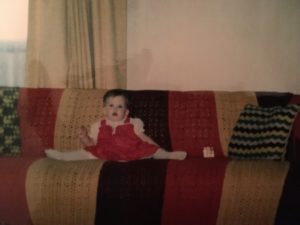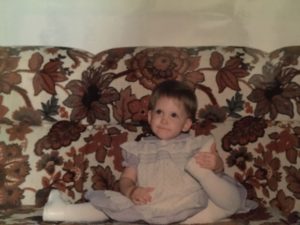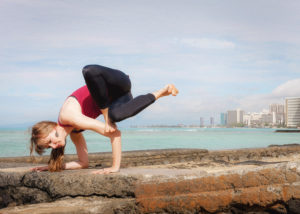When I was 6 months old my Dad was changing my diaper and noticed that one of my legs was longer than the other.
My Mom, a nurse, consulted a Pediatric nursing book she had (this was 1981 – we were a looooong way from Google) and suspected that I had Bilateral Congenital Hip Dysplasia. My Mom had heard of this condition, had studied it, and knew what it meant: I had no hip sockets. My parents made an appointment with my family doctor, my hips were x-rayed, and the doctor called the next day to confirm the diagnosis. He made an appointment with a St. John’s doctor (we lived in Corner Brook – an 8 hour drive away) so I could get admitted to the Janeway Children’s Hospital and start treatment.
Here’s what was going on:
My legs (femur bones) were pushed up past where my hip sockets should be, so the first step in the treatment process was traction: I was on my back for 6 weeks and the traction allowed my legs to be pulled down to where my hip sockets should be.
The next step was to create hip sockets: this was possible because I was so young and my bones were still soft. I had been lying down for 6 weeks straight so I had to get used to sitting up and being upright again. Once I was acclimatized my legs were put in a splint and I wore a full body brace that tied up around my shoulders to keep my legs in a frog-like position: this allowed the top part of my femur to press up into hip area to form hip sockets.


After a couple of months I busted out of that contraption so we went to St. John’s again and this time I was outfitted in a different brace that kept my legs in an open split.


All was well until I was 5 years old and the public health nurse at school alerted my parents that my feet were turning in. My family doctor sent me to an Orthopedic surgeon who said that I would have arthritis by age 16 and a hip replacement would follow. The surgeon wouldn’t give my parents a referral for a second opinion because he said they didn’t need one.
My family doctor agreed to refer us to a renowned surgeon in Toronto (a 3.5 hour flight to the mainland) but when the office took so long to call for an appointment my Mom called the specialist and pretended to be our family doctor’s secretary (go Mom!) We had our appointment for the Hospital for Sick Children in Toronto.
The specialist there actually disagreed with the arthritis and hip replacement prognosis and said that if I sat in a cross legged seat (like Sukhasana) for 2 hours a day (instead of the Saddle position I was sitting in) my feet would straighten up. And they did.
Life was good. I was very active in junior high and high school: I played sports, I went to the gym, and I functioned like any other growing kid and never noticed anything different about my body or my mobility. The treatment hadn’t worked for some of the other babies that had been in the hospital when I was there so I considered myself to be very lucky. And treatment not working meant that those teenagers now had one leg longer than the other and had wear special shoes to compensate for the height difference.
In my mid 20s I noticed stiffness in my right hip and I started to think about the predictions of arthritis and hip replacements. It scared me. So I did something about it. I started to stretch. I would sit in Sukhasana and I would fold forward, breathe, count. It felt good. I did it every day.
In 2008 I went to New York for a month long Yoga Teacher Training course (mainly because I was feeling stressed and troubled and wanted to learn more about the healing properties of yoga). I noticed that I wasn’t as flexible as others: my hip mobility limited and hip opening postures like Lizard and Pigeon, which most people seemed to love, were pure torture for me.
My most memorable moment in my Yoga Teacher Training was watching a video called “The Fuzz Speech.” In it, anatomist Gil Hedley presents 2 cadavers: the body of someone who had been active, and the body of someone who hadn’t. It was shocking to see the difference. In the video, Gil talks about fascia, which is connective tissue that covers the whole body; “fuzz” or stiffness can set in if the muscle fascia starts to bind together due to a lack of movement and stretching.
I heard his message loud and clear: move it or lose it.
And I was definitely inspired to move it.
When I got home I practiced yoga daily. I even did a 30 day Pigeon pose challenge, holding the pose for 2-3 minutes each day (basically for the duration of a Beatles song). By day 15 I could see a difference: my hips were opening up and becoming less stiff.
I could see the power of movement and stretching.
I knew that I could take control and change my body.
And what an incredibly empowering realization that was.
I’m grateful to have a job where I move every day. I don’t know what my hip would be like today if I wasn’t doing yoga, or if I had a job where I was sitting 6-8hrs/day. Sitting is the New Smoking – have you heard that? How about Ways a Sedentary Lifestyle Is Killing You? Forbes, The Globe & Mail, The Huffington Post, and the Mayo Clinic all have articles outlining the dangerous effects of our increasingly sedentary lifestyles.
The message is clear: we have to be active, we have to get moving, we have to keep the fuzz at bay.
I don’t take anything I can do with my body for granted. I’m so grateful that I can walk for hours, move without pain, and practice yoga.
I wasn’t born able to do the yoga poses that I can do – quite the opposite, actually. I learned to do these poses and I trained my body to be able to move this way.
And I’ll tell you what I tell my yoga students when it comes to being active, getting moving, and overcoming physical challenges:
If I can do it, you can do it.
-melanie-
xo


